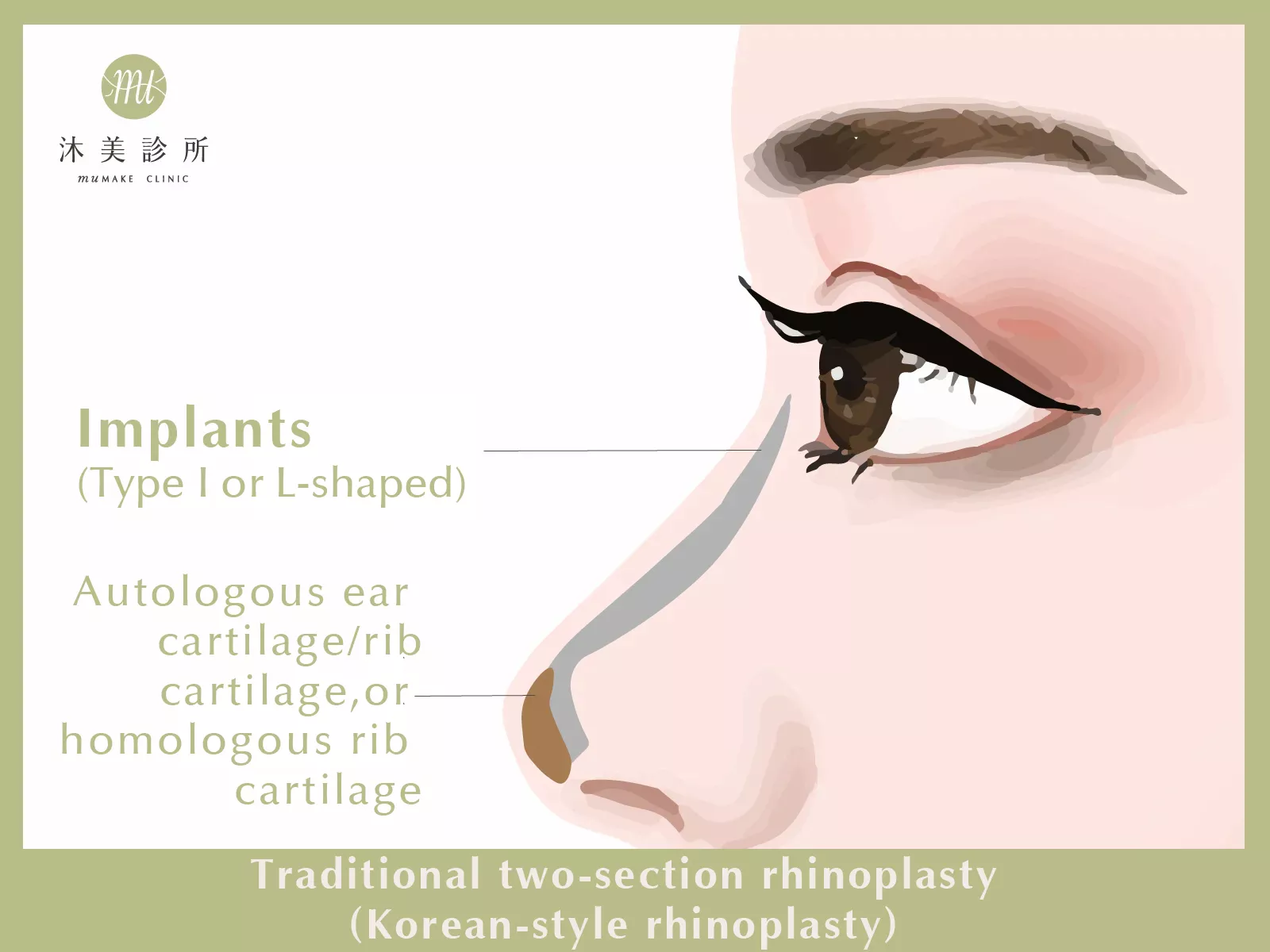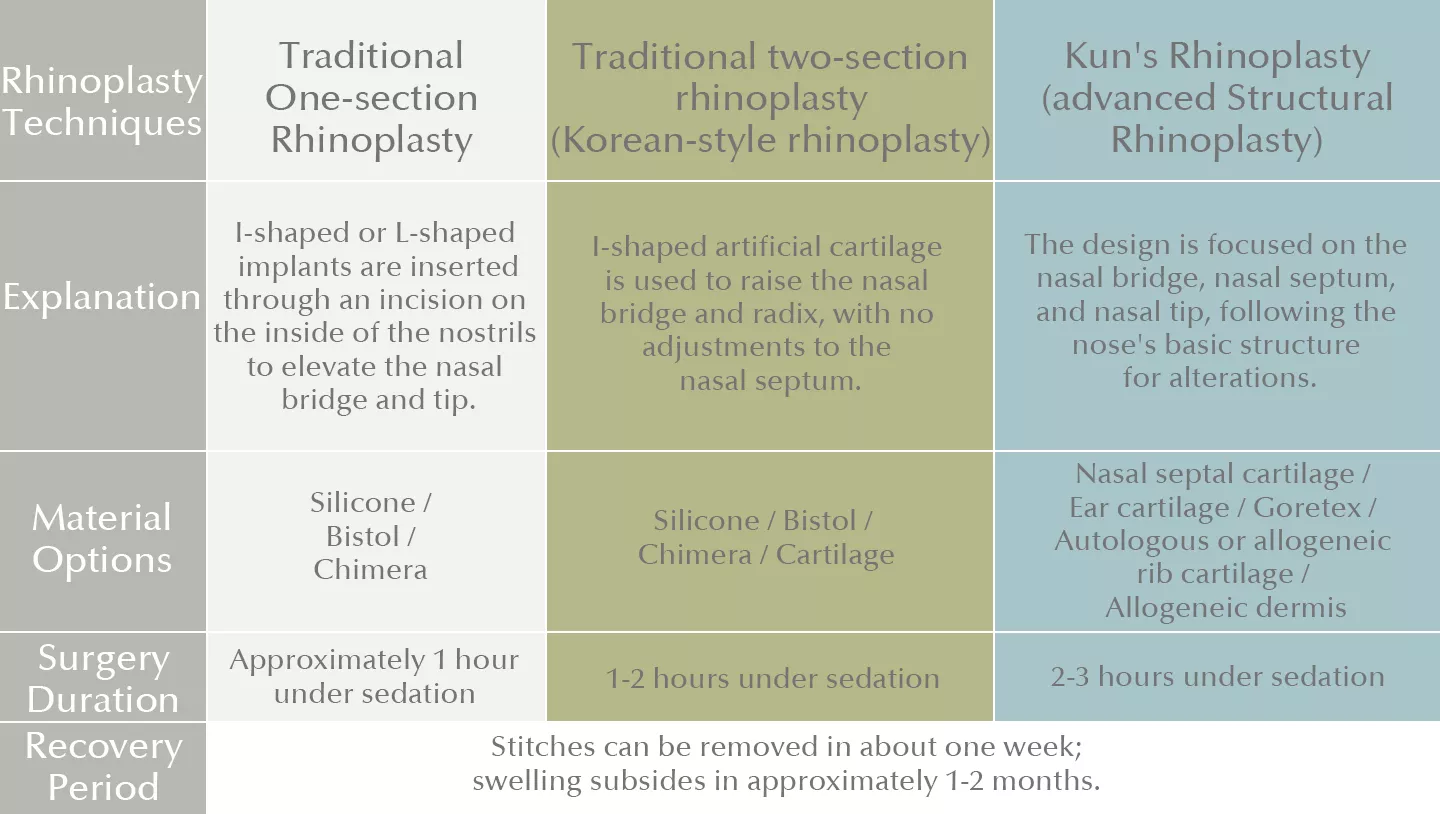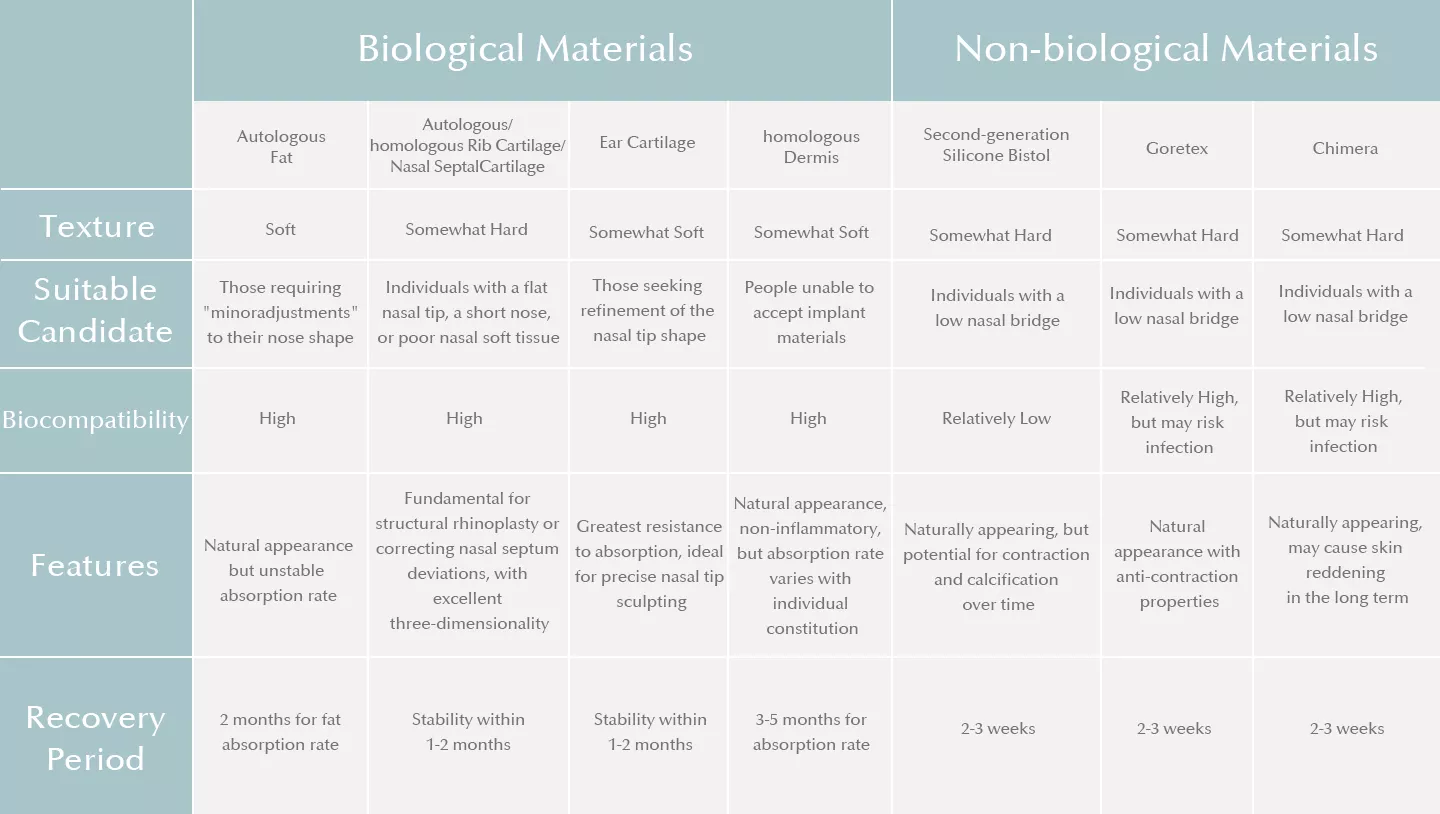The essence of structural rhinoplasty lies in the ability to perform a safe "customized procedure" for various parts of the nose, achieving the most balanced, aesthetically pleasing, and naturally beautiful new nose for each individual.
What issues can structural rhinoplasty address?

Traditional Rhinoplasty vs. "Kun's Rhinoplasty"
Rhinoplasty comes in various methods and should be tailored to the individual's nose shape, conditions, and their desired outcome. However, traditional rhinoplasty techniques (one-stage, two-stage) address fewer nose issues. Unless the individual's conditions are already very favorable, for safety and contemporary aesthetic considerations, "structural rhinoplasty" is generally recommended.

Among these, under the refinement of Dr. Chen Chen-kun, the Medical Technology Director of Mumake Clinic, and his nearly 20 years of rhinoplasty experience, the most adaptable and naturally, safely, and aesthetically pleasing technique for various nose shapes has been designed: "Kun's Rhinoplasty".
Traditional One-Stage Rhinoplasty

An L-shaped implant (typically silicone gel in earlier procedures) is inserted through inner nostril incisions to raise the nasal bridge and tip. The procedure is simple and quick, but long-term calcification of silicone implants inside the body is possible, and it lacks the stability for nasal tip shaping provided by the nasal septum, making it susceptible to contracture and even the potential for extrusion. Traditional L-shaped implants are rarely used as an option in modern rhinoplasty procedures.
Traditional two-section rhinoplasty (Korean-style rhinoplasty)

I-shaped artificial cartilage is used to elevate the nasal bridge and radix of the nose, along with cartilage grafting at the top of the nose, which, in combination with tip cartilage grafting, can also protect against implant extrusion. However, without adjustments to the nasal septum, the tip cartilage cannot be reshaped completely, and it is not suitable for thoroughly adjusting noses that are too short, too long, too large, or too round. Therefore, the two-sectional method is only suitable for clients with a naturally attractive nose shape who simply want to increase height.
NEW "Kun's Rhinoplasty"

Step 1: Nasal Septum Repositioning
The nasal septum serves as the foundation for rhinoplasty, similar to building a house requiring a solid foundation. Many people have congenital underdeveloped or deviated nasal septum, resulting in crooked noses, short noses, upturned noses, wide noses, saddle noses, and other common Asian nose shapes. At this section, using autologous rib cartilage or other homologous biological materials can rebuild the rhinoplasty foundation and even extend the nasal septum, preparing for a more elegant and attractive nose shape.
Step 2: Designing the "Complex Radix"
After positioning the nasal septum as the foundation, Goretex and allogeneic rib cartilage are used to sculpt the radix height and width that best fit the client's nose shape, considering facial balance. Autologous biological materials (e.g., homologous dermal powder and homologous dermal sheets) are extended to the glabella, creating smoother and more attractive Venus lines and mid-nose aesthetics. If the client has excessively wide nasal bones, this step can also involve osteotomies to refine the radix, ensuring it complements the face shape.
Step 3: Sculpting the Nasal Tip
In the final step, similar to placing the last strawberry on top of a cake, autologous ear cartilage, with a small amount of allogeneic dermal tissue, is used to extend the nasal column, adjust and sculpt the nasal tip's shape (narrowing, elongating, or reshaping the nasal nostrils). Attention is also paid to creating a perfect "seagull" line to achieve a comprehensive rhinoplasty result.
Comparison of Rhinoplasty Techniques

With so many rhinoplasty material options, which one is suitable for me?

Biological Materials
(1) Autologous Fat
With the invention of the fat gun, autologous fat grafting has become more precise and can be used for rhinoplasty or around the nose area, such as the nasal bridge. However, fat grafting is subject to absorption, making it more suitable for clients looking for "minor adjustments" to their nose shape.
(2) Rib Cartilage (Autologous/homologous) / Nasal Septal Cartilage
Whether autologous or homologous rib cartilage or nasal septal cartilage, they generally do not pose issues related to rejection. They are commonly used as the foundation for structural rhinoplasty and can effectively address issues related to nasal tip height, projection, size, or length, which are significant considerations in Asian rhinoplasty. Especially in cases where the surgery involves correcting a deviated nasal septum, these materials are indispensable. However, rib cartilage, due to its inherent curvature, may exhibit curvature issues in about 2-5% of cases, which requires the surgeon's experience to address.
(3) Ear Cartilage
Ear cartilage is relatively soft and has the lowest absorption rate among all cartilage materials, making it the preferred choice for nasal tip sculpting.
(4) homologous Dermis
Similar to human collagen, allogeneic dermis has undergone biological processing and is not associated with rejection issues. It is a legal material for use in Taiwan's cosmetic and plastic surgery procedures and is often used in rhinoplasty, the correction of eye bags, and addressing nasolabial folds.
Non-biological Materials
(1) Silicone
Traditional rhinoplasty often used silicone as an implant material. While silicone is considered non-carcinogenic for the human body, it has long-term issues with calcification, capsule contracture, and can lead to problems such as making the nasal bridge too thin, short, or crooked. These issues have led experienced rhinoplasty surgeons to be cautious about using silicone implants.
(2) Goretex
With over 20 years of accumulated experience, Goretex, originally a human substitute material used in cardiac vascular and craniofacial reconstructions, has become the preferred choice for many experienced rhinoplasty surgeons. Goretex-based nasal implants come in two categories: Chimera and all-Goretex implants.
Chimera implants have an inner layer of silicone and an outer layer of Goretex, which generally resembles the shape of silicone implants. However, the outer layer's close integration with the surrounding tissue helps reduce the occurrence of contracture or curvature issues.
In contrast to Chimera implants, all-Goretex implants are softer and provide better conformity to different nasal bridge shapes. Since they are entirely made of Goretex, they are more effective in resisting contracture and curvature issues.
Design considerations must also account for the conditions of the nasal tip and the tension of the nasal skin. According to Dr. Chen Chenkun, the choice of Goretex material challenges the professionalism and experience of surgeons, and extra care must be taken to ensure sterility.
The fundamental difference between all-Goretex and Chimera nasal implants lies in their conformity to the nasal tissue and their integration with the surrounding tissues. In both aspects, all-Goretex implants have the advantage. Therefore, the benefit of using all-Goretex nasal implants is that they create a highly natural nasal bridge, especially for clients with thinner skin, wider nasal bridge bases, or unique nasal bone curves, achieving a better natural result. Conversely, if a client desires a particularly high and straight nasal bridge or has thicker skin, Chimera implants can also provide the expected outcome.
Witness
※The case photos in this text are clinic's pre- and post-operative photos, used for treatment explanation or supplementary educational information. They are for reference only. According to the announcement of the Ministry of Health and Welfare, the case records obtained patient consent and are not medical advertisements.



Q:Can rhinoplasty improve nasal allergies?
A:Rhinoplasty is unrelated to nasal allergies, and it cannot improve allergic rhinitis.
Q:Can I touch my nose, pick my nose, or blow my nose after rhinoplasty?
A:Do not touch your nose, pick your nose, or blow your nose for the first two weeks after surgery. Avoid vigorous exercise within a month to prevent implant displacement. If your nose feels itchy, you can clean it with a clean cotton swab dipped in saline solution.
Q:What is the recovery time for rhinoplasty?
A:Recovery time varies from person to person, but typically, noticeable swelling subsides after about one month. To achieve complete shaping, it usually takes about three to four months.
Q:Is rhinoplasty painful?
A:Rhinoplasty is performed under anesthesia, so it is not painful during the surgery. After returning home, once the anesthesia wears off, you may feel some swelling and numbness, along with mild discomfort, but not severe pain. Pain during suture removal is generally tolerable.
Q:Can rhinoplasty be performed after having hyaluronic acid injections in the nose?
A:Yes, it is possible. However, any residual material from previous injections needs to be completely removed during surgery.
Q:How many times can I undergo rhinoplasty?
A:Due to the formation of internal scars during surgery, it is generally recommended not to undergo rhinoplasty more than three times. If there are special requirements, thorough discussions with the physician are necessary to ensure safe procedures.
Q:Will rhinoplasty leave visible scars?
A:Rhinoplasty is a minimally invasive procedure, and even if there are scars, they will be located inside the nostrils and not very noticeable. Similarly, when reshaping the nasal tip using ear cartilage, the incisions are designed to be discreetly placed behind the ears.
Q:What should I do about wearing glasses during the recovery period?
A:For safety reasons, it is recommended not to wear glasses for the first month if possible. If necessary, consider using contact lenses to avoid artificial nasal bone displacement.
Q:How to care for your nose after surgery?
(1) Handle your nose with care:For the first month, avoid touching, picking, or blowing your nose. If you experience an itch or need to sneeze, make sure to open your mouth to prevent pressure on your nasal tissues.
(2) Go makeup-free but not glasses-free:For the first month after surgery, avoid wearing makeup and glasses to prevent postoperative nose deformations and infection. You can wear contact lenses.
(3) Avoid heavy lifting:After rhinoplasty, refrain from lifting heavy objects and exerting excessive force, including bending over. Delegate tasks like tying shoelaces to someone else, or wear slip-on shoes.
(4) Sleep adjustments:Use a high pillow and avoid sleeping face-down; instead, sleep on your back. To alleviate nasal congestion, elevate your head at a 30-degree angle.
(5) Maintain a mild diet and avoid alcohol and smoking:Avoid overly spicy or hot foods, as well as smoking and alcohol consumption.
(6) Follow the instructions provided by the nurses for taking oral medications, changing ointments, and applying cold packs, among other aftercare steps.
Note:This translation is for informational purposes only and does not constitute medical advice. Always consult with a qualified medical professional for specific medical concerns or questions regarding rhinoplasty or any surgical procedures.




 Booking Now
Booking Now  Messenger
Messenger  LINE
LINE 


